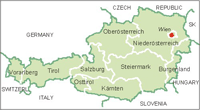
About Carinthia
 Carinthia, in German Karnten, province in Southern Austria (1991 pop. 547,798, 9,531 sq km.)
Carinthia, in German Karnten, province in Southern Austria (1991 pop. 547,798, 9,531 sq km.)Klagenfurt is the capital. Predominantly mountainous, it is the southernmost Austrian province, bordering on Italy and Slovenia in the south. The Grossglockner , the highest point in Austria (12,460 ft/3,797 m), rises in the northeast, at the Tyrol province border. Carinthia has mines (lead, zinc, and magnesite) and well-developed farms (especially in the fertile Drava, or Drau, plain). Manufactures of the province include electrotechnical products, shoes, paper and pulp, and chemicals. There is also an active tourist trade, particularly along the Worther See, a lake near Klagenfurt.
 In 976, Carinthia, which then included Istria, Carniola, and Styria, was detached from Bavaria and made an independent duchy. Acquired by Ottocar II of Bohemia in 1269, it fell to Rudolf I of Hapsburg in 1276 and in 1335 became an Austrian crown land. By the Treaty of Saint-Germain (1919) the province lost some minor territories to Italy and Yugoslavia. The only Austrian province with an appreciable ethnic minority, Carinthia has a Slovene population of approximately 2.7% in the south.
In 976, Carinthia, which then included Istria, Carniola, and Styria, was detached from Bavaria and made an independent duchy. Acquired by Ottocar II of Bohemia in 1269, it fell to Rudolf I of Hapsburg in 1276 and in 1335 became an Austrian crown land. By the Treaty of Saint-Germain (1919) the province lost some minor territories to Italy and Yugoslavia. The only Austrian province with an appreciable ethnic minority, Carinthia has a Slovene population of approximately 2.7% in the south. Back to top
Back to top


 Romana
Romana English
English











